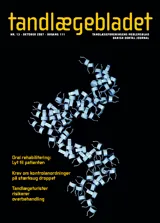Behandlingsplanlægning i oral rehabilitering, som inkluderer livskvalitetsaspekter. En metodevurdering
Beslutningsprocesserne i forbindelse med oral rehabilitering bygger ofte på »bløde« værdier, hvilket gør diagnostikken usikker. Ved at bruge en mere strukturel og individuel indgangsvinkel skulle det være muligt at afdække den enkelte patients ønsker og dermed optimere behandlingsvalget. »Schedule for the Evaluation of Individual Quality of Life - Direct Weighting« (SEIQoL-DW) er en metode, der bruger et kvalitativt interview samt en vurdering og prioritering af oralt relaterede områder, som patienten angiver som vigtige til at give struktur i samtalen omkring den individuelle behandlingsplan. Metoden blev afprøvet på en gruppe med partielle proteser og en gruppe partielt tandløse uden aftagelig erstatning. Det antages, at metoden kan give klinikeren et værdifuldt indblik i den enkelte patients tanker og ønsker angående behandlingen. Den kan dermed bruges i den individuelle behandlingsplanlægning. Yderligere undersøgelser skal klarlægge validiteten af metodens enkelte komponenter samt vurdere metodens anvendelighed i undervisning og almindelig praksis.
Treatment planning in oral rehabilitation including quality of life aspects. An evaluation of a method. In oral rehabilitation the indication for treatment is of- ten based on ‘soft’ values, such as the patients’ needs and wishes. There is a distinct lack of structure in the evaluation of these individual patient’s needs and expectations, thereby making it difficult to incorporate them in decision-making. By introducing structured analysis of individual planning wishes and incorporation of these in the planning, it might be possible to optimize the treatment. A method (SEIQoL-DW) which allows structure and maximum matching of treatment plans to individuals was used on a group of partially edentulous persons with removable dental prostheses and a group of partially edentulous persons without removable dental prostheses. The method consists of an interview and a measurement of the actual status as well as the priority given by the patient to the important areas of treatment. The method can give the clinician a valuable insight into the patients’ thoughts, thereby giving optimal conditions for individualized treatment planning. More studies are needed to evaluate the method and its components before it can be recommended for use in general practice and teaching.


